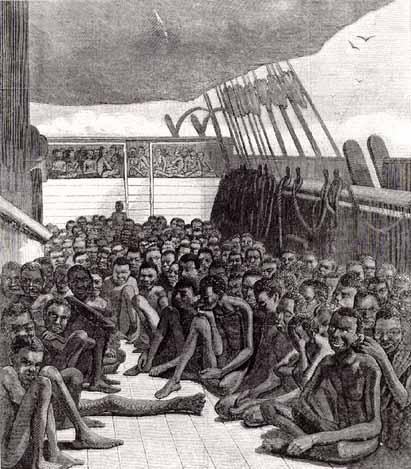Try It
In Equiano’s narrative he describes how he is held in a ship carrying captives to sell in the New World. For sometimes as long as a year, captives waited in the dungeons of the slave factories scattered along the western coast of Africa after being captured from their villages. The captives eventually left on the infamous Middle Passage, the middle leg of a three-part voyage -- a voyage that began and ended in Europe. The first leg of the voyage carried a cargo to trade in Africa. Upon landing on Africa's "slave coast," the cargo was exchanged for Africans. Fully loaded with its human cargo, the ship set sail for the Americas in deplorable conditions for the captives. The slaves were exchanged for sugar, tobacco or some other product. The final leg brought the ship back to Europe.

Equiano describes the deplorable conditions slaves endured on the Middle Passage.
Now read and annotate another passage from Chapter II, looking again at the five elements that are part of the author’s craft and the structure of the text.
Five Elements
- Diction - the word choice, connotation and denotation of words and their impact
- Mood - the feelings and atmosphere the passage evokes in the reader
- Point of View - what you can learn from the perspective from which the narrative is told
- Author’s Purpose - the reasons behind the author’s account
- Organization of Ideas - why the passage is organized the way it is
As you read, consider the following strategies that will help you complete the exercises that follow:
- Identify examples of descriptive language in the narrative.
- Look at the physical hardships the captives suffered during the Middle Passage.
- Look for examples of evidence of the cruel treatment by the slave traders.
- Look at the descriptions of the emotional damage inflicted on the captives.
Download a Chapter II excerpt #2 from Equiano’s narrative.
After you finish annotating your copy of the passage, answer the text-dependent questions below.


